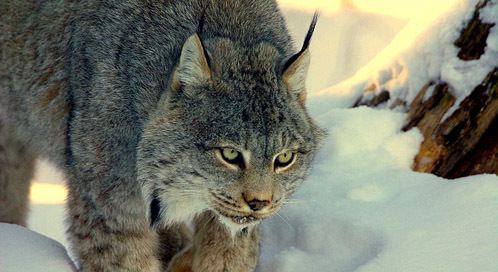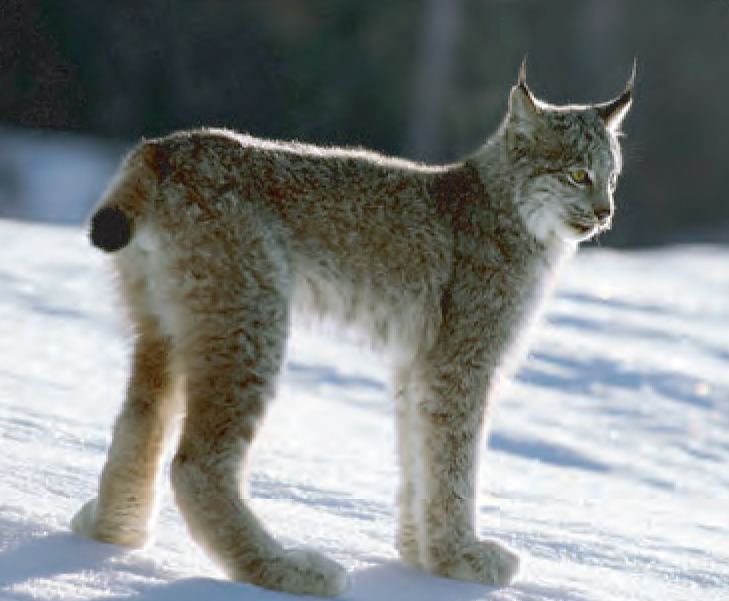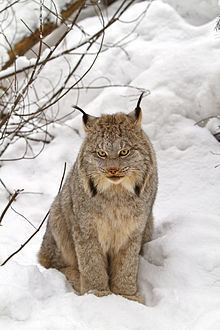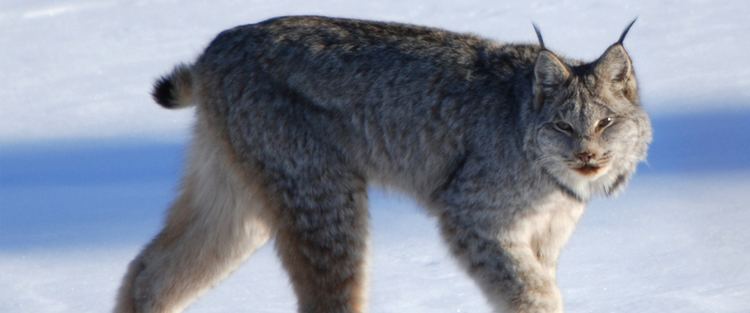Length 76 – 110 cm (Adult) Rank Species | Phylum Chordata Genus Lynx Mass 8 – 11 kg (Adult) Gestation period 64 days | |
 | ||
Height 48 – 56 cm (Adult, At Shoulder) Similar | ||
Max canada lynx i m a big baby
The Canada lynx (Lynx canadensis) or Canadian lynx is a North American mammal of the cat family, Felidae. With the recognised subspecies, it ranges across Canada and into Alaska as well as some parts of the northern United States and extending down the Rocky Mountains to Colorado, where they were reintroduced in the 1990s.
Contents
- Max canada lynx i m a big baby
- Taxonomy and evolution
- Physical characteristics
- Ecology and behaviour
- Home ranges
- Diet and hunting
- Reproduction
- Distribution and habitat
- Cycle of abundance
- Conservation
- References

With a dense silvery-brown coat, ruffed face and tufted ears, the Canada lynx resembles the other species of the mid-sized Lynx genus. It is slightly larger than the bobcat, with which it shares parts of its range, and over twice the size of the domestic cat.

Taxonomy and evolution

The Canada lynx is one of the four members of the genus Lynx, and is classified under the family Felidae. It was first described by scientific writer Robert Kerr in his 1792 work The Animal Kingdom as Felis lynx canadensis. The taxonomy of lynxes has remained in dispute; it is not even clear if Lynx should be considered an independent genus or a subgenus of Felis. Even the status of the Canada lynx as an independent species is doubted by some authorities. For instance, Renn Tumlinson considers the Canada lynx as a subspecies of the Eurasian lynx (L. lynx) in his 1987 account of the Eurasian lynx in Mammalian Species. However, some authorities like zoologist W. Christopher Wozencraft, who revised the classification of carnivorans in 1989 and 1993, consider the two to be separate species.

According to a 2006 study based on genetic analysis, the ancestor of five felid lineages – Lynx, Leopardus, Puma, Felis and Prionailurus plus Otocolobus – arrived in North America after crossing the Bering Strait 8.5–8 mya. Lynx diverged from the Puma, Felis and Prionailurus plus Otocolobus lineages around 3.24 mya. The Issoire lynx (L. issiodorensis), that probably originated in Africa 4 mya and occurred in Europe and northern Asia until it became extinct around 1 mya, is believed to be the ancestor of the four modern species of Lynx. A 1987 study suggested that the populations of the Eurasian lynx that reached North America 20,000 years ago initially moved toward the southern half of the continent, as the northern part was covered by glaciers. The southern populations gradually evolved into the modern bobcat (L. rufus). Later, when the continent was invaded by the Eurasian lynx for a second time, the populations that settled in the northern part of the continent, now devoid of glaciers, evolved into the Canadian lynx. The 2006 study gave the phylogenetic relationships of the Canada lynx as follows:
Two subspecies of the Canada lynx are recognised:
Physical characteristics
The Canada lynx is a medium-sized cat, similar in many ways to the bobcat. This lynx is between 80 and 100 centimetres (31 and 39 in) in head-and-body length, stands 48–56 centimetres (19–22 in) tall at the shoulder and weighs 5–18 kilograms (11–40 lb). Physical proportions do not vary significantly across its range. The Canada lynx is sexually dimorphic, with males larger and heavier than females. This lynx is smaller than the Eurasian lynx by almost two times, probably a naturally selected characteristic to allow the animal to survive on smaller prey. Like the bobcat, the Canada lynx has forelimbs shorter than the hindlimbs, so that the back appears to be sloping downward. The stubby tail, typical of lynxes, measures 5–15 centimetres (2.0–5.9 in).
The coat is generally yellowish brown (though the back is sometimes grey); the dense, long fur insulates it in its frosty habitat. Though no melanistic or albinistic forms of the Canada lynx are known, "blue" lynxes have been reported from Alaska. Black hair tufts (4 centimetres (1.6 in) long), a feature common to all lynxes, emerge from the tips of the ears, which are lined with black. In winter, the hair on the lower cheeks grow so long that it appears to form a ruffle covering the throat. Some dark spots can be seen on the underbelly, where the fur is white (sometimes with a hint of buff); there are four nipples. The coat is short and reddish brown to greyish in summer, but becomes notably longer and greyer in winter, with a mix of greyish brown and buff hairs; the spots may become more distinct in summer. The tail is marked with dark rings and, unlike the tail of the bobcat, terminates in a fully black tip. The paws, covered in long and thick fur, can support nearly double the weight the paws of a bobcat can bear.
The Canada lynx has 28 teeth, same as in other lynxes but unlike other felids, with four long canines for puncturing and gripping. The lynx can feel where it is biting the prey with its canines because they are heavily laced with nerves. The lynx also has four carnassial teeth that cut the meat into small pieces. In order for the lynx to use its carnassials, it must chew the meat with its head to its side. There are large spaces between the four canines and the rest of the teeth, and the second upper premolars are absent, to ensure that the bite goes as deeply as possible into the prey. The claws are sharp and completely retractable (capable of being drawn within). The paws, broadened by the wide-spaced metatarsals, can spread as wide as 10 centimetres (3.9 in) and allow the lynx to move fast and with ease on the snow. The spoor is more distinct in hard snow than in mud, though the toes are not clearly visible in deep snow.
The Canada lynx differs from the bobcat in having longer ear tufts, a greyer and less red coat, less distinct spotting on the coat, a slightly shorter tail completely black on the tip rather than only on the upper side, and larger paws. The bobcat is generally smaller than the Canada lynx, but may still be confused in areas where their ranges overlap, because bobcats tend to be larger in such areas. The caracal resembles the lynxes in having similar tufts on the ears.
Ecology and behaviour
The Canada lynx tends to be nocturnal (active mainly at night), like the snowshoe hare, its major prey. Nevertheless, activity may be observed during daytime. The lynx can cover 8–9 kilometres (5.0–5.6 mi) everyday to procure prey, moving at 0.75–1.46 km/h (0.47–0.91 mph). Lynxes are good swimmers; one account records a lynx swimming two miles across the Yukon River. The Canada lynx is an efficient climber, and will dodge predators by climbing high up on trees; however, they hunt only on land. Canada lynxes are primarily solitary, with minimal social interaction except for the mother-offspring bond and the temporary association between males and females during the mating season.
Home ranges
Canada lynxes establish home ranges that vary widely in size, depending upon the method of measurement. The two common methods are examining the tracks of the lynx on snow (snow-tracking) and radio telemetry; snow-tracking generally gives smaller sizes for home ranges. Studies based on snow-tracking have estimated home range sizes of 11.1–49.5 square kilometres (4.3–19.1 sq mi), while those based on radio telemetry have given the area between 8 and 783 square kilometres (3.1 and 302.3 sq mi). Like other cats, Canada lynxes scent-mark their ranges by spraying urine and depositing faeces on snow or tree stumps and other prominent sites in and around their range.
Males tend to occupy larger ranges than do females; for instance, based on data from a 1980 radio telemetric analysis in Minnesota, the home ranges of males covered 145–243 square kilometres (56–94 sq mi), while those of females covered 51–122 square kilometres (20–47 sq mi). The study coincided with an immigration of lynxes into Minnesota, where hares occurred in small numbers. In another radio telemetric study in 1985 in Montana, male home ranges averaged 122 square kilometres (47 sq mi) and those of females averaged 43.1 square kilometres (16.6 sq mi). In a study in the southern Northwest Territories, ranges of individuals of opposite sexes were found to overlap extensively, while the ranges of individuals of the same sex hardly coincided. The study suggested that individuals tend to avoid one another and thus passively defend their ranges.
Factors such as availability of prey (primarily snowshoe hare), density of lynxes and the topography of the habitat determine the shape and size of the home range. Studies have tried to correlate the abundance of snowshoe hares in an area with the sizes of lynx home ranges in that area. A 1985 study showed that the mean size of home ranges trebled—from 13.2 to 39.2 square kilometres (5.1 to 15.1 sq mi)—when the density of hares fell from 14.7 to 1 per hectare (5.95 to 0.40/acre). However, a few other studies have reported different responses from lynxes at times of prey scarcity; some lynxes do not show any changes in their ranges, while others may resort to hunting in small areas, occupying small home ranges. Canada lynxes generally do not leave their home ranges frequently, though limited prey availability can be a factor powerful enough to cause lynxes to disperse or expand their ranges.
Diet and hunting
Carnivores, Canada lynxes depend heavily on snowshoe hares for food. These hares comprise 35–97% of their diet; their occurrence in the diet varies by abundance of hares and the season. Snowshoe hare populations in Alaska and central Canada undergo cyclic rises and falls – at times the population densities can fall from as high as 2,300 per square kilometre (6,000/sq mi) to as low as 12 per square kilometre (31/sq mi). Consequently, a period of hare scarcity occurs every 8 to 11 years. During these times, lynxes will include other animals – such as ducks, grouse, moles, ptarmigan, red squirrels, voles and young ungulates (Dall's sheep, mule deer and reindeer) – in their diet, though snowshoe hares are still the primary component. The Canada lynx tends to be less selective in summer and autumn, preying on other small mammals, though snowshoe hares continue to prevail in the diet. Canada lynxes consume one hare every one to two days, such that they consume 600–1,200 grams (21–42 oz) of food everyday.
A study of coyotes and Canada lynxes in southwest Yukon Territory showed that during that phase of the snowshoe hare abundance cycle when their numbers increased, both predators killed more hares than were needed for their subsistence; lynxes need to kill 0.4 to 0.5 hares per day to meet their energy requirements, but were observed to kill 1.2 hares per day during the study. Coyotes, with a success rate of 36.9%, emerged as more successful hunters than lynxes (though this may have been caused due to a greater number of adult coyotes in the studied population), that succeeded in 28.7% of their hunts. Lynxes rarely cached their kills, unlike coyotes, and this may have led to incomplete consumption of some kills. During the cyclic decrease in snowshoe hare numbers, both predators hunted for the same time period as they did when hares were abundant, but lynxes killed more hares than they did earlier. Moreover, lynxes supplemented their diet with red squirrels.
Canada lynxes hunt around twilight or at night, the time when snowshoe hares tend to be active. Lynxes rely on their vision and sense of hearing to locate prey. The lynx will roam or wait on certain trails where snowshoe hares gather, pounce on a hare and kill it by a bite on its head, throat or the nape of its neck. Young ungulates are given a throat bite to suffocate them to death. They can eat their kill immediately or cache them in snow or leaves to eat them over the next few days. Lynxes will occasionally hunt together, and achieve success rates as 55% – notably greater than that achieved when they hunt singly (14%). Scavenging is common in Canada lynxes; they will take ungulates killed in the cold or by roadkill.
Reproduction
The breeding season in Canada lynx lasts only for a month, ranging from March to May, depending on the local climate. Females come into oestrus only once during this period, lasting for three to five days. The female attracts a mate by leaving some of her urine where the male has marked his territory, and by repeated calling. Mating can occur six times in one hour. The female lynx will only mate with one male each season, but the male may mate with multiple females.
Gestation lasts around 64 days, so that the young are born in May or early June. Before birth, the female prepares a maternal den, usually in very thick brush, and typically inside thickets of shrubs or trees or woody debris. The dens are generally situated mid-slope and face south or southwest.
Litters contain from one to four kittens, and tend to be much larger when prey is abundant. This suggests a greater degree of reproductive flexibility than in other cats, and females often do not mate at all when prey is scarce. When kittens are born in lean years, however, infant mortality may be as high as 95%.
Canada lynx kittens weigh from 175 to 235 g (6.2 to 8.3 oz) at birth, and initially have greyish buff fur with black markings. They are blind and helpless for the first fourteen days, and weaned at twelve weeks. When their eyes open, they are a bright blue colour, but as they mature, the eyes become a brown-hazel colour. The mother brings the food to her kittens and allows them to play with it before eating it, thus training their hunting skills.
Kittens leave the den after about five weeks, and begin hunting at between seven and nine months of age. They leave the mother at around ten months, as the next breeding season begins, but do not reach the full adult size until around two years old. Females reach sexual maturity at ten months, although they often delay breeding for another year, while males reach maturity at two or three years. Canada lynx have been reported to live for up to fourteen years in captivity although the lifespan is likely much shorter in the wild.
Distribution and habitat
The Canada lynx is found in northern and mixed forests across Canada and Alaska. It is, however, absent in the relatively treeless regions of the Great Plains and the northern coasts, which are outside the natural range of the snowshoe hare. Due to human activity, the Canada lynx is no longer found on Prince Edward Island or on the mainland of Nova Scotia, although there are two known areas of Canada lynx populations in the Cape Breton Highlands.
In addition, there are large populations of this lynx in Montana, Idaho, Washington, and Oregon, and a resident population exists in Yellowstone National Park, Wyoming, that extends into the Greater Yellowstone Ecosystem. The Canada lynx is rare in Utah, Minnesota, and New England. The Canada lynx is a threatened species in the contiguous United States. It is also found in the Medicine Bow National Forest in Wyoming.
A Canada lynx was shot near Newton Abbott in the United Kingdom in 1903 after attacking two dogs. The dead lynx was preserved by Bristol Museum and Art Gallery, and scientists identified it after analysis over a century later. They concluded that it had probably been captive for some time, perhaps as an exotic pet or part of a travelling menagerie, but may have survived for a substantial period after escaping. They considered it "the earliest recorded example of an exotic cat on the loose in the UK".
Starting in 1999, the Colorado Division of Wildlife began a program reintroducing a wild lynx population of 96 to Colorado. While showing early signs of promise, biologists say it will take more than a decade to determine whether the program is a success. However, in 2003 lynx den visits identified 16 native-born Colorado lynx, and the next year, 39 new lynx kittens were identified, confirming the possibility of successful reintroduction.
In 2007 several of these lynx were shot and killed by unknown persons. In some cases only the radio tracking collars were found, leading to suspicions of fur poaching; in other cases the animals were shot and the body left intact.
By 2010, after an 11-year effort, the lynx had been successfully reintroduced into Colorado, where it had become extinct in the 1970s. The initial introduction was in the San Juan Mountains in southwestern Colorado, but self-sustaining populations were established throughout the south-central Colorado Rockies as far north as Summit County by 2010. In Colorado the red squirrel is an important secondary food source when snowshoe hares are scarce. Isolated individual lynx have wandered widely from the core area in the Southern Rockies where they were reintroduced, resulting in observation of lynx introduced in Colorado as far away as Iowa, northern Idaho, and eastern Nevada. It was found helpful to rest and feed the animals well before releasing them in prime condition during the spring thaw.
Cycle of abundance
In northern Canada, the abundance of lynx can be estimated from the records kept of the number caught each year for their fur. Records have been kept by the Hudson's Bay Company and Canadian government since the 1730s. A cycle of its abundance is characterised by huge rises and falls, with the peaks occurring at a level typically ten times higher than the troughs and following about five years after them; the cycle then reverses. The exceptionally long data set from historical records of fur purchases from trappers is a common case study, appearing in many secondary school and university textbooks worldwide.
This lynx is a specialist predator, eating snowshoe hare almost exclusively when they are available. The population variation of the lynx and the hare is an example of a predator-prey cycle. Environmental factors such as weather and forest plant growth that may affect this population variation have been studied.
Conservation
The Canada lynx is trapped for its fur, and has declined in many areas due to habitat loss; however, the IUCN lists them as a species of Least Concern. On March 24, 2000, the U.S. Fish and Wildlife Service issued its Final Rule, which designated the Canada lynx a Threatened Species in the southern-most 48 states. Canada lynx-bobcat hybrids have also been detected at the southern periphery of the current population range for lynx (Maine, Minnesota and New Brunswick), which may limit their recovery in the south.
